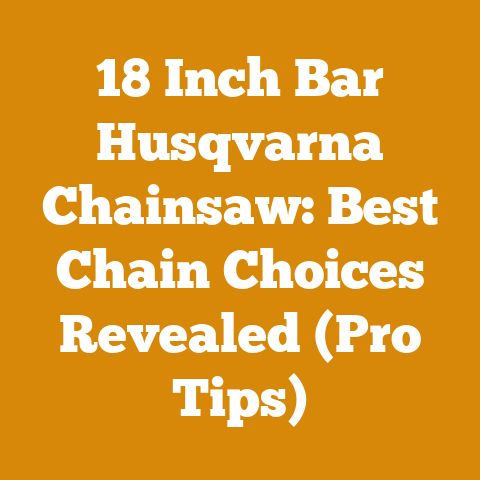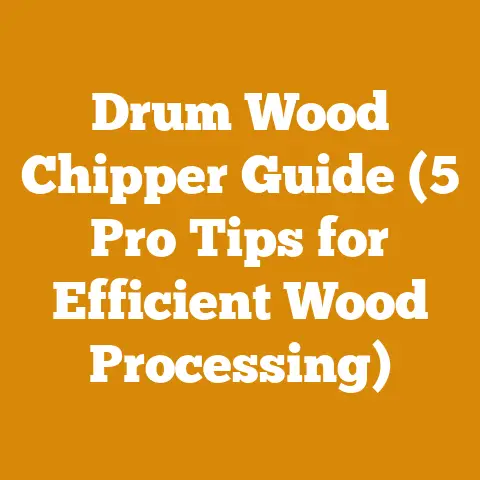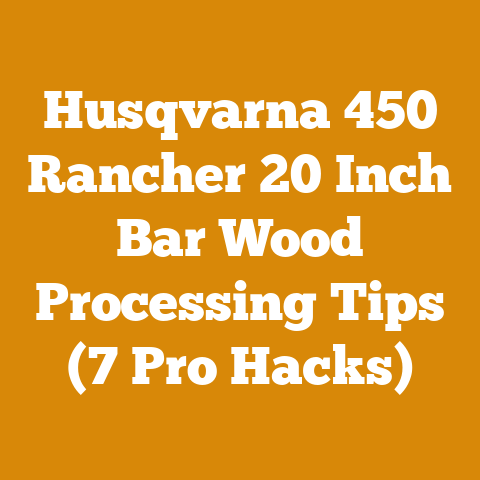Wheel Horse Mower Decks for Woodlands (Side/Rear-Discharge Hacks)
Have you ever stood at the edge of your property, gazing at a sea of unruly saplings and thick underbrush, and wondered how to tame it all with your trusty Wheel Horse? The dream of transforming that wild patch into a usable woodland space often clashes with the reality of limited equipment and challenging terrain. Mowing woodlands with a Wheel Horse isn’t as simple as cutting a suburban lawn. It demands a strategic approach, the right modifications, and a deep understanding of your machine’s capabilities. I’ve spent years wrestling with this very challenge, turning overgrown areas into manageable, aesthetically pleasing woodlands. In this article, I’ll share my experiences and knowledge on adapting Wheel Horse mower decks for woodland clearing, focusing on side- and rear-discharge hacks that can make a world of difference. Let’s dive in and unlock the potential of your Wheel Horse for tackling those tough woodland projects.
Understanding the Challenge: Woodlands vs. Lawns
Before diving into modifications, it’s crucial to understand the fundamental differences between mowing a lawn and clearing a woodland. Lawns are typically composed of fine grasses, regularly maintained, and relatively free of obstacles. Woodlands, on the other hand, present a host of challenges:
- Dense Undergrowth: Woodlands are often choked with thick undergrowth, including saplings, brambles, and tough weeds.
- Uneven Terrain: The ground is rarely level, with hidden roots, rocks, and depressions that can damage equipment.
- Debris: Fallen branches, leaves, and other organic matter accumulate, creating a thick layer of debris that can clog mower decks.
- Obstacles: Trees, shrubs, and other obstacles require careful maneuvering and can limit access to certain areas.
These challenges demand a different approach to mowing, one that prioritizes durability, power, and the ability to handle large volumes of material.
Why Modify a Wheel Horse Mower Deck?
Wheel Horse tractors are renowned for their robustness and longevity. Their mower decks, while designed primarily for lawn mowing, can be adapted to handle the rigors of woodland clearing with some strategic modifications. Here’s why you might consider modifying your Wheel Horse mower deck:
- Cost-Effectiveness: Purchasing a dedicated brush hog or forestry mower can be a significant investment. Modifying your existing Wheel Horse mower deck offers a more affordable alternative.
- Versatility: A modified mower deck allows you to tackle both lawn mowing and woodland clearing tasks with the same machine.
- Maneuverability: Wheel Horse tractors are typically more compact and maneuverable than larger brush hogs, making them ideal for navigating tight spaces in woodlands.
- Existing Investment: If you already own a Wheel Horse tractor, modifying the mower deck is a logical extension of your existing investment.
Side-Discharge vs. Rear-Discharge: Which is Right for You?
The choice between side-discharge and rear-discharge mower decks depends on your specific needs and the nature of your woodland clearing project.
- Side-Discharge: Side-discharge mower decks eject clippings out the side of the deck. This is generally suitable for lawns and lighter brush, but it can struggle with dense undergrowth and large volumes of debris.
- Rear-Discharge: Rear-discharge mower decks discharge clippings out the back of the deck. This design is often preferred for woodland clearing because it can handle larger volumes of material and distribute it more evenly. It also reduces the risk of throwing debris, which is a safety concern in wooded areas.
For woodland applications, I generally recommend rear-discharge modifications due to their superior ability to handle dense material and minimize the risk of thrown debris.
Modifying a Side-Discharge Deck for Woodland Clearing
While rear-discharge is often preferred, it’s possible to enhance a side-discharge deck for light woodland clearing. Here’s how:
-
Reinforce the Deck: The stock mower deck is not designed for the abuse of woodland clearing. Reinforce the deck by welding additional steel plates to the underside and around the edges. This will help prevent bending and cracking from impacts with rocks and roots. I personally use 1/4″ steel plating for reinforcement.
-
Upgrade the Blades: Replace the standard lawn mowing blades with heavier-duty brush blades. These blades are thicker and more durable, designed to withstand impacts with tough vegetation and debris. Look for blades specifically designed for brush mowing or shredding.
-
Install a Mulching Kit (Optional): A mulching kit can help chop up clippings into finer pieces, reducing the volume of material ejected from the side of the deck. This can be beneficial for controlling the spread of weeds and promoting decomposition.
-
Add a Deflector Shield: Install a deflector shield to the side of the deck to prevent debris from being thrown towards the operator. This is an important safety measure, especially when clearing areas with dense undergrowth.
-
Increase Cutting Height: Adjust the cutting height to the highest setting to avoid scalping the ground and reduce the risk of hitting obstacles. This also allows the mower to handle taller vegetation more easily.
-
Sharpen Blades Frequently: Woodland clearing dulls blades quickly. Sharpen blades after each use to maintain cutting efficiency and reduce strain on the mower.
Converting a Side-Discharge Deck to Rear-Discharge
Converting a side-discharge deck to rear-discharge requires more extensive modifications, but it can significantly improve the deck’s performance in woodland clearing applications. Here’s a step-by-step guide based on my own experience:
-
Remove the Side Discharge Chute: Begin by removing the side discharge chute from the mower deck. This will create an opening for the rear discharge.
-
Fabricate a Rear Discharge Chute: Fabricate a rear discharge chute from sheet metal or steel. The chute should be wide enough to accommodate the flow of clippings and angled downwards to direct the material towards the ground. I recommend using 16-gauge steel for durability.
-
Weld the Chute to the Deck: Weld the rear discharge chute to the mower deck, ensuring a secure and watertight connection. Pay close attention to the angle and alignment of the chute to ensure proper discharge.
-
Install a Baffle: Install a baffle inside the mower deck to direct the flow of clippings towards the rear discharge chute. The baffle should be positioned to prevent clippings from accumulating in the front of the deck.
-
Reinforce the Rear of the Deck: Reinforce the rear of the mower deck to withstand the increased stress from the rear discharge. Weld additional steel plates to the underside and around the edges of the deck.
-
Balance the Blades: After making these modifications, it’s crucial to balance the blades to prevent vibration and ensure smooth operation. Use a blade balancer to check the balance and make any necessary adjustments.
Enhancements Applicable to Both Side and Rear Discharge Mower Decks
Regardless of whether you stick with side-discharge or convert to rear-discharge, some enhancements apply to both deck types.
-
Skid Plates: Adding skid plates to the bottom edges of the mower deck will protect it from abrasion and damage when mowing over uneven terrain.
-
Chain Guards: Install chain guards around the perimeter of the mower deck to prevent debris from being thrown outwards. This is especially important when mowing near roads or other areas where people may be present.
-
Solid Tires: Replace the pneumatic tires on the tractor with solid tires to eliminate the risk of punctures and improve traction.
-
ROPS (Roll-Over Protection Structure): If your Wheel Horse tractor does not already have a ROPS, consider installing one for added safety. This will protect you in the event of a rollover.
-
Lighting: Add additional lighting to the tractor, especially if you plan to mow in low-light conditions.
Blade Selection for Woodland Clearing
The blades are the workhorses of your mower deck, and selecting the right ones is crucial for effective woodland clearing. Here’s a breakdown of different blade types and their applications:
- Standard Lawn Mowing Blades: These blades are designed for cutting fine grasses and are not suitable for woodland clearing. They are too thin and fragile to withstand the impacts of tough vegetation and debris.
- Brush Blades: Brush blades are thicker and more durable than standard lawn mowing blades. They are designed for cutting heavier vegetation, such as saplings, brambles, and tough weeds.
- Shredder Blades: Shredder blades have multiple cutting edges and are designed to chop up clippings into finer pieces. They are ideal for mulching and controlling the spread of weeds.
- Gator Blades: Gator blades have a unique design that creates a strong updraft, lifting clippings and chopping them into finer pieces. They are a good all-around choice for both lawn mowing and light woodland clearing.
For most woodland clearing applications, I recommend using brush blades or gator blades. Brush blades are the most durable option, while gator blades offer a good balance of cutting performance and mulching ability.
Power Considerations: Ensuring Adequate Horsepower
Woodland clearing places a significant demand on your tractor’s engine. Ensure that your Wheel Horse tractor has adequate horsepower to power the modified mower deck. A general rule of thumb is that you need at least 1 horsepower per foot of mower deck width. For example, a 48-inch mower deck would require at least 4 horsepower.
If your tractor is underpowered, you may experience reduced cutting performance, increased fuel consumption, and premature engine wear. Consider upgrading to a more powerful engine or reducing the width of the mower deck to improve performance.
Safety First: Protecting Yourself and Others
Woodland clearing can be a hazardous activity. Always prioritize safety and take the necessary precautions to protect yourself and others.
- Wear appropriate personal protective equipment (PPE), including safety glasses, hearing protection, gloves, and sturdy boots.
- Clear the area of any obstacles before mowing.
- Never operate the mower deck with the safety shields removed.
- Be aware of your surroundings and watch out for people, animals, and other hazards.
- Never allow anyone to stand in front of the mower deck while it is operating.
- Stop the engine and remove the key before making any adjustments or repairs to the mower deck.
- Inspect the mower deck regularly for any signs of damage or wear.
- Keep the blades sharp and properly balanced.
- Store the tractor and mower deck in a safe and secure location when not in use.
Real-World Examples and Case Studies
To illustrate the effectiveness of these modifications, let’s look at a few real-world examples and case studies.
Case Study 1: Converting a Side-Discharge Deck for Trail Maintenance
A local hiking club needed a way to maintain trails in a wooded area. They had an old Wheel Horse tractor with a side-discharge mower deck. They converted the deck to rear-discharge using the steps outlined above and installed brush blades. The modified mower deck proved to be highly effective at clearing brush and maintaining the trails.
Case Study 2: Reinforcing a Side-Discharge Deck for Light Brush Clearing
A homeowner wanted to clear light brush and undergrowth from a wooded area on their property. They reinforced the side-discharge mower deck with steel plating and installed gator blades. The modified mower deck was able to handle the light brush clearing tasks without any issues.
Personal Experience: Taming My Overgrown Backyard
I had a similar challenge in my own backyard. A section of my property had become overgrown with weeds, brambles, and small saplings. I decided to modify my Wheel Horse mower deck to tackle the problem.
I started by reinforcing the deck with steel plating and installing brush blades. I then added a deflector shield to the side of the deck to prevent debris from being thrown towards my house. I also increased the cutting height to the highest setting.
The modified mower deck worked like a charm. I was able to clear the overgrown area in a matter of hours. The brush blades easily sliced through the tough vegetation, and the deflector shield kept the debris contained.
Cost-Benefit Analysis
Modifying a Wheel Horse mower deck for woodland clearing can be a cost-effective alternative to purchasing a dedicated brush hog or forestry mower. Here’s a cost-benefit analysis:
Costs:
- Steel plating: \$50-\$100
- Brush blades: \$30-\$50
- Welding supplies: \$20-\$40
- Fabrication materials (for rear-discharge conversion): \$50-\$100
- Labor (if you hire someone to do the welding): \$100-\$300
Benefits:
- Cost savings compared to purchasing a dedicated brush hog or forestry mower (which can cost thousands of dollars).
- Versatility: The modified mower deck can be used for both lawn mowing and woodland clearing tasks.
- Maneuverability: Wheel Horse tractors are typically more compact and maneuverable than larger brush hogs.
- Existing Investment: If you already own a Wheel Horse tractor, modifying the mower deck is a logical extension of your existing investment.
In most cases, the cost of modifying a Wheel Horse mower deck is significantly less than the cost of purchasing a dedicated brush hog or forestry mower. This makes it a cost-effective option for homeowners and small landowners who need to clear brush and undergrowth on a limited budget.
Ongoing Maintenance and Care
Once you’ve modified your Wheel Horse mower deck for woodland clearing, it’s important to maintain it properly to ensure its longevity and performance.
- Sharpen the blades regularly. Dull blades will reduce cutting efficiency and put unnecessary strain on the mower.
- Inspect the deck regularly for any signs of damage or wear. Repair any damage promptly to prevent further problems.
- Grease the spindles and other moving parts regularly. This will help keep them lubricated and prevent wear.
- Store the mower deck in a dry and protected location when not in use.
- Follow the manufacturer’s recommendations for maintenance and care.
Troubleshooting Common Problems
Even with proper maintenance, you may encounter some common problems when using a modified Wheel Horse mower deck for woodland clearing. Here are some troubleshooting tips:
- Mower deck is not cutting effectively: Check the blades for sharpness and damage. Also, check the engine for adequate power.
- Mower deck is vibrating excessively: Check the blades for balance. Also, check the spindles for wear.
- Mower deck is clogging with debris: Increase the cutting height. Also, try using a different type of blade.
- Mower deck is throwing debris: Install chain guards around the perimeter of the deck. Also, reduce the cutting speed.
Alternatives to Mower Deck Modification
While modifying a Wheel Horse mower deck can be a cost-effective solution for woodland clearing, it’s not the only option. Here are some alternatives:
- Brush Hog: A brush hog is a dedicated piece of equipment designed for clearing heavy brush and undergrowth. Brush hogs are typically more powerful and durable than modified mower decks, but they are also more expensive.
- Forestry Mower: A forestry mower is a specialized type of brush hog designed for clearing large areas of trees and brush. Forestry mowers are typically mounted on heavy equipment, such as skid steers or excavators.
- Manual Clearing: Manual clearing involves using hand tools, such as chainsaws, brush axes, and loppers, to clear brush and undergrowth. Manual clearing is labor-intensive, but it can be a good option for small areas or areas where equipment access is limited.
- Professional Land Clearing Services: If you don’t have the time or equipment to clear your woodland yourself, you can hire a professional land clearing service. Land clearing services typically use heavy equipment to clear large areas of trees and brush.
Conclusion: Unleash the Potential of Your Wheel Horse
Modifying a Wheel Horse mower deck for woodland clearing can be a rewarding and cost-effective way to tame unruly landscapes. By reinforcing the deck, upgrading the blades, and considering a rear-discharge conversion, you can transform your trusty Wheel Horse into a capable woodland clearing machine. Remember to prioritize safety, maintain your equipment properly, and troubleshoot any problems that may arise. With the right modifications and a little elbow grease, you can unlock the full potential of your Wheel Horse and create a beautiful and manageable woodland space.
The key takeaways are:
- Assess your needs and choose the right modifications for your specific woodland clearing project.
- Prioritize safety and wear appropriate personal protective equipment.
- Maintain your equipment properly to ensure its longevity and performance.
- Consider the alternatives to mower deck modification, such as brush hogs, forestry mowers, and manual clearing.
Now, it’s time to get out there and start transforming your woodland!






